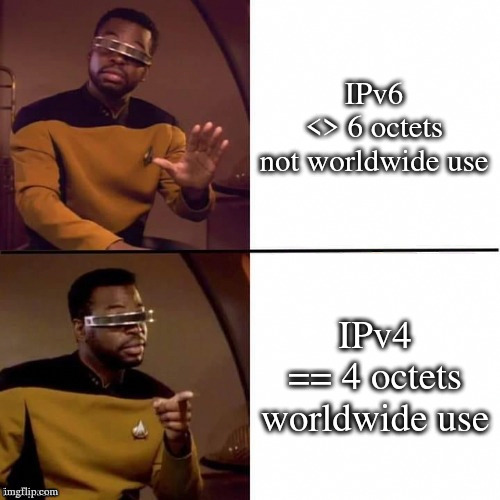this post was submitted on 19 Jun 2024
314 points (85.7% liked)
Programmer Humor
19589 readers
607 users here now
Welcome to Programmer Humor!
This is a place where you can post jokes, memes, humor, etc. related to programming!
For sharing awful code theres also Programming Horror.
Rules
- Keep content in english
- No advertisements
- Posts must be related to programming or programmer topics
founded 1 year ago
MODERATORS
you are viewing a single comment's thread
view the rest of the comments
view the rest of the comments

So you don’t need to change your network if your isp changes.
You shouldn’t have to?? Maybe you might need to change the mask in your firewall settings if the ipv6 allocation block size changes but that should be it.
Everything else should just work as normal.
You should only assign static ipv6 to servers, in theory you could just define a host id and use a prefix too. But, most people at home really aren't running enough servers to make that worthwhile. Everything else should just pick up new addresses fine using ND.
There ought to be more servers.
Will the app for the smart thermostat be updated three years from now and still be useful? If it was instead a web server app on a routable IP, it wouldn't matter provided they didn't fuck up the authentication and access control.
Yeah, but they're not. That's the modern world. But also even if it was a web server there's usually ways to advertise the IP for the app to connect to. I've seen other stuff do that. So getting an IP is easy. Once the app knows the IP and if you really want to allow connections from outside to your IOT devices (I wouldn't) it could remember the IP and allow that.
You really don't need to give a fixed IP to everything. I think I've given 1 or 2 things fixed IPv6 IPs. Everything else is fine with what it assigns itself.
The other app off the top of my head is VoIP. You should be able to "dial" a number directly. Most solutions go through the company's data center first in order to pierce through NAT. Which makes it more expensive, less reliable, slower, and more susceptible to snooping.
There's a "if you build it, they will come" effect here. Once you can address hosts directly, a whole bunch of things become better, and new ideas that were infeasible are now feasible. They don't exist now because they can't.
You can use ULAs (unique local addresses) or that purpose. Your devices can have a ULA IPv6 address that's constant, and a public IPv6 that changes. Both can be assigned using SLAAC (no manual config required).
I do this because the /56 IPv6 range provided by my ISP is dynamic, and periodically changes.
Yes but you’d still be performing NAT. It’s at least 1:1.
You’ll need to deal with firewall rules regardless, and drop IPs into policies. IPv6 doesn’t remove any of those chores but gets rid of having to maintain tables to deal with many-to-one NAT.
You wouldn't need NAT. The ULA is used on the internal network, and the public IP is for internet access. Neither of those need NAT.
What translates the public ip to the internal ip? Aren’t they different?
There's no translation between them. With IPv6, one network interface can have multiple IPs. A ULA (internal IP) is only used on your local network. Any internet-connected devices will also have a public IPv6 address.
ULAs aren't too common. A lot of IPv6-enabled systems only have one IP: The private one.
If you use a single shared public ip then you’re using some amount of address translation.
If you’re using an external ip address that’s different than an internal ip address but both are assigned to a single host the you’re doing 1:1 NAT.
At least that’s how I understand ipv4 and I don’t think ipv6 is much different.
This is practically never the case with IPv6. Usually, each device gets its own public IP. This is how the IPv4 internet used to work in the old days (one IP = one device), and it solves so many problems. No need for NAT traversal since there's no NAT. No need for split horizon DNS since the same IP works both inside and outside your network.
There's still a firewall on the router, of course.
With IPv6, each network device can have multiple IPs. If you have an internal IP for whatever reason, it's in addition to your public IP, not instead of it.
IPs are often allocated using SLAAC (stateless address auto config). The router tells the client "I have a network you can use; its IP range is
2001:whatever/64, and the client auto-generates an IP in that range, either based on the MAC address (always the same) or random, depending on if privacy extensions are enabled - usually on for client systems and off for servers.Just like ipv4 though, you wouldn’t use external addresses internally because your external IPs might change, such as when moving between ISPs. You would NAT a hosts external address to its internal address.
This is true
This is usually not true.
If you're worried about your external IP changing (like if you're hosting a server on it), you'd solve it the same way you solve it with IPv4: Using dynamic DNS. The main difference is that you run the DDNS client on the computer rather than the router. If there's multiple systems you want to be able to access externally, you'd habe multiple DDNS hostnames.
DNS doesn’t propagate fast enough.
The solution to that is to buy a net block. IPV6 address space is very affordable.